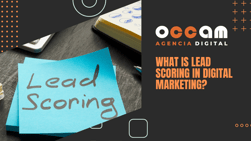Index Content
Lead scoring is a lead scoring technique used to identify those leads that are most likely to purchase. The objective is achieved through a qualification based on the consumer's interest and profile. Leads are prioritised and identified to improve the productivity of marketing and sales teams. This methodology allows analysis of the degree of likelihood of purchase, obtained through the quality and intensity of the customer's interactions with the company.
In digital marketing, a lead is a person or entity interested in the products and services of a business. Therefore, it is part of the database and is in a position to interact with the content of the website. Lead scoring is a useful automation tool to understand the role of these leads. It seeks to offer leads a score in relation to the buyer persona selected by the company. Depending on the situation in which they find themselves during the buying process, they will be renamed as cold or warm leads. By focusing on the user experience, lead scoring is essential to carry out an Inbound Marketing strategy.
what is lead scoring for?
- To find out the customer's level of interest in a product or service.
- To generate qualified leads.
- To convert users who are at another point in the sales funnel.
- To discard leads that do not match the brand's commercial criteria.
- Evaluate the success of a marketing strategy.
Benefits of lead scoring in inbound marketing
- Segment user profiles: If the database grows, it is difficult to know each profile in depth. It is convenient to divide the contacts in order to know how to treat them. Thus, lead scoring serves to classify contacts into different users and stages.
- Itmeasures the effectiveness of the campaign: Without lead scoring, you get to know the number of your company's customers, but not their profile or what stage they are in. Thanks to this tool you can analyse this data and know if the marketing strategy used is the right one. Mitigating errors is easier because you can find out at what point the leads lose interest.
- Processes a large amount of data: This methodology also serves as an organisational method for the company. When working with a large amount of data, some can be lost or misused. Lead scoring allows us to organise the data in a systematic way and treat it objectively based on our business objectives.
- Automation: In marketing 4.0, automating strategies is key to advance in the process of capturing leads. An automated communication strategy can be established, saving time for the team. In addition, having information about each user segment, messages can be personalised.
what parameters affect lead scoring?
- Company data (for organisations looking for B2B or B2C companies).
- Personal data (demographics, gender, age, occupation...).
- Interaction with the website.
- Social media interaction.
- Email marketingfeedback.
- Negative score when detecting spam.
Types of lead scoring
Depending on the objectives established by the company, it will be advisable to use one type of lead scoring or another, as each one focuses on providing a series of benefits. These are the main ones:
- Unidimensional Lead Scoring: Leads are qualified with a score from 0 to 100. This score is based on the closeness to the ideal client or buyer persona. Its degree of reliability is variable because it does not focus on the maturation process. That is, some criteria are forgotten, automatically discarding leads with lower qualification that, perhaps, were also prepared for the purchase. Within this type we find the retrospective lead scoring, which considers the permanence of the lead in the company and the predictive lead scoring, which analyses the behaviour of the lead predicting future actions.
- Multidimensional lead scoring: Its main feature is that it considers various parameters in its score. Elements such as previous knowledge of the company, interaction in social networks or similarity with the buyer persona determine the lead's qualification. This type of lead scoring is used to calculate customer loyalty with greater accuracy.
Types of lead scoring systems
Depending on the investment power of the company and its knowledge, one lead scoring system or another can be used. These are the main ones:
- Manual: The most rudimentary process. It is based on guessing and manual work. It is determined by a qualifier in charge of filtering the leads it considers to have the most potential. It is inaccurate and costly.
- Semi-automated: In this case the marketing team uses Excel sheets to segment lead groups, but the available digital tools are still not exploited. Although the work can be divided among more than one person and organised properly, a lot of data can be lost in the process.
- Automatic: Using automation tools, no need to improvise. If only one score is given to the lead, it is considered automatic-simple; if two different scores are given, taking into account other criteria, it is considered automatic-complete.
- Automatic-predictive: This type of tool goes one step further in lead scoring. In addition to scoring and determining qualified leads, it analyses information and predicts a series of data for the future. This software has a higher cost.
5 steps to create lead scoring
1. Define your buyer personaWith lead scoring, you know how close the lead is to the buyer persona. You need to know what qualities the lead needs to meet in order to develop your marketing strategy.
2. Decide on the scoring valuesChoosing the right scoring parameters for your business is essential because the leads will be segmented correctly. You must establish a relationship between the values related to the profile and the interest.
3. Know the conversion rateTo calculate the actions that were effective for each profile, it is useful to calculate the conversion of leads to customers. This result can be obtained by dividing the sales by the number of leads in each segment.
4. Apply scoresOnce the conversion rate results have been obtained, a score should be determined for each lead behaviour. This step personalises the lead scoring for your company.
5. ActWith the lead scoring data, specific actions can be developed for each customer to achieve a purchase process. These strategies can include mailing, the creation of a corporate blog or loyalty programmes.
3 best practices when using lead scoring
- Determine relevant parameters for the company.
- Work with closed fields on landing pages.
- Use automation software.
3 mistakes when using lead scoring
- Using too many variables to score leads.
- Optimising lead scoring settings only at the beginning.
- Not acting after knowing the data.
Platforms for using lead scoring
HubSpot: This software is characterised by offering an intuitive configuration. In one place, it brings together the necessary tools to capture leads in compliance with the Inbound Marketing methodology. It scores predictively by machine learning and allows you to create different scoring strategies depending on the campaign. The MQLs can be divided based on their score. For example, a first group can be baptised as MQL 1 for matching the buyer persona; another MQL 2, for having previous knowledge of the company; and a third group as MQL 3, being the leads that are closest to making a purchase.
Marketo: This platform is an alternative to the pioneer HubSpot as it has a similar operation. It uses inbound marketing strategies, process automation and email marketing. In lead scoring, it offers lead scoring accompanied by tips to measure, enhance and strengthen the flow of potential customers.
Net-Results: With this software, all kinds of processes can be automated, including lead scoring. During lead scoring, segments are identified based on the qualities that are considered necessary for the purchase. This saves time and helps to decide which marketing actions should be implemented.






